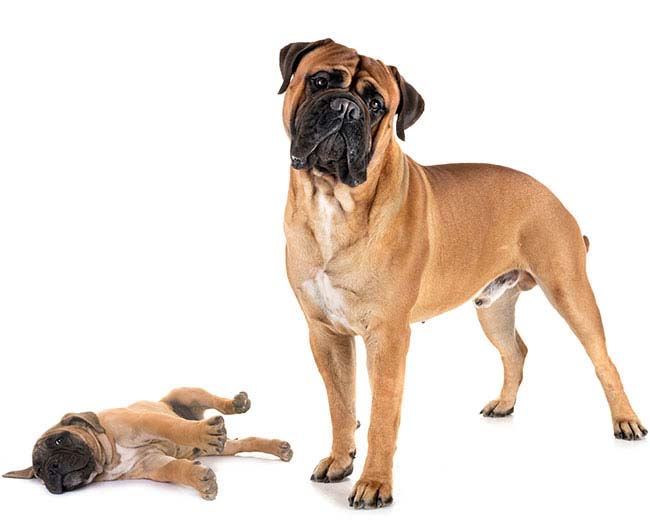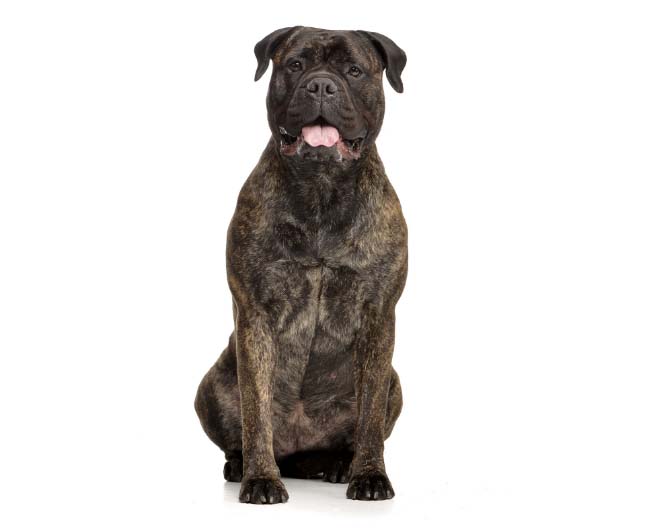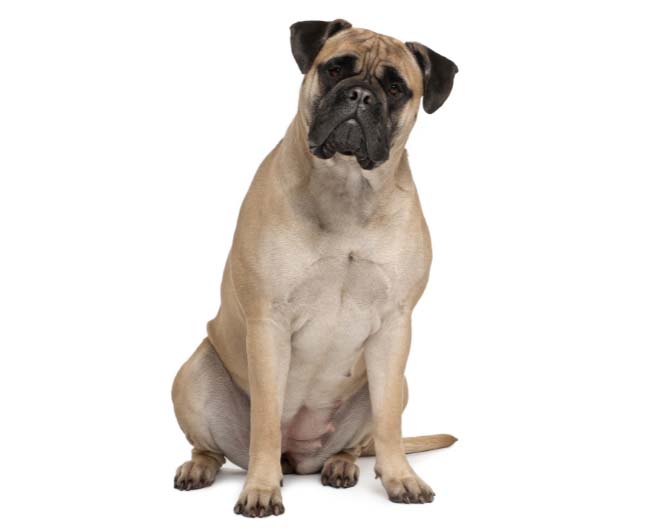We've gone Pink to help fight Breast Cancer.
Use code "BREAST" and we'll Donate $50 to National Breast Cancer Foundation
Main Menu
Petsy Breed Pages
The world’s most comprehensive information on the ...

$500.00 - $3000.00
Mastiff
Extra large
Working Group
Short
Medium
Extra high
8 to 10 years

Would you like to know what it would cost to insure an Bullmastiff? Find out by getting a free quote, with petsy pet insurance.











Bullmastiff come in a variety of colours, including Fawn, Brindle, Red, Fawn, Fawn.


How much do
Bullmastiff eat?
1.50 to 2.00 cups of food a day

How much
exercise do they need?
20 to 40 Mins

Are they kid friendly? Gentle companions who love kids

Do they need a lot of space? They make fine apartment pets and do not require a yard
Patellar Luxation
Legg-Perthes Disease
Hip Dysplasia
Heart murmurs
They are recommended to have 3 1/8 to 4 1/8 cups of high-quality dog food, divided into two meals. Rather than putting food out all the time, measure their food and feed them twice a day to keep your Bullmastiff in good form.
Treats can be an important aid in training, but giving too many can cause obesity. Safe, clean water should be available at all times to keep them hydrated.
Bullmastiffs don't shed much, and their coats are easy to keep clean and shining with a little brushing with a rubber curry on a daily basis. Brushing them with a rubber grooming mitt or tool or a de-shedding glove once a week will help remove dead hair and keep them looking good.
Keeping them clean and neat does not take so much effort. Begin accustoming them to being brushed and examined when they are still puppy. Handle their paws frequently ? dogs are touchy about their feet ? and look inside their mouth.
Trim their nails once or twice a month if your dog doesn't wear them down naturally to prevent painful tears and other problems. Their ears should be checked weekly for redness or a bad odour, which can indicate an infection.
Your careful weekly exam will help you spot potential health problems early.
Bullmastiffs will require at least two hours of exercise.
Taking them on a brisk stroll two to three times a day should be enough. They make excellent jogging and hiking partners, but you must wait until the dog is two years old to avoid damaging the dog's developing joints.
Physical activity can make them happy and healthy!
They may require more frequent vet visits as early detection is key in giving the best possible treatment of any health conditions that may arise. Routine checkups also provide the chance to track your dog's growth and development and forms a key part of preventative care.
Bullmastiffs are gentle and affectionate to their family. Their calm, easygoing personalities make them ideal pets for families with well-behaved youngsters.
They may also be less tolerant of animal members of a family than of human members. Bullmastiffs are good guard dogs since they were developed to protect the territory from poachers.
These dogs are a protective breed that would put their lives on the line for them.
Bullmastiffs are quick to learn because of their high intelligence. However, they can also be independent and prone to distraction.
So, you'll need to win their loyalty and respect without using threats or physical aggression, leading to resentment. They do best with a combination of firm, fair, consistent rules, positive reinforcement, and rewards for correct behaviour.
Use positive training techniques, rewarding them with praise, play, or treats when they perform commands correctly.
Bullmastiffs can get along well with other dogs and cats if they are properly socialized earlier. Interacting with cats might be challenging for them, especially that they have a strong predatory impulse. And as naturally territorial animals, they aren't fond of living with other dogs of the same gender, regardless of breed. Proper training will help them learn how to behave well around them.
Here are some of the breeders who we work with as part of our breeder awareness program.
They are invested in ensuring the longevity of the breed and that new owner become responsible Affenpinchers owners.
Affenpinchers who are friends of Petsy





Enter your email in the form below and we will send you the full report as a pdf directly to your inbox.
Don’t worry, we hate spam too – read our privacy policy
Find the right level of insurance for your needs our customised quote takes less than a few minutes to complete.
They are recommended to have 3 1/8 to 4 1/8 cups of high-quality dog food, divided into two meals. Rather than putting food out all the time, measure their food and feed them twice a day to keep your Bullmastiff in good form.
Treats can be an important aid in training, but giving too many can cause obesity. Safe, clean water should be available at all times to keep them hydrated.
Bullmastiffs will require at least two hours of exercise.
Taking them on a brisk stroll two to three times a day should be enough. They make excellent jogging and hiking partners, but you must wait until the dog is two years old to avoid damaging the dog's developing joints.
Physical activity can make them happy and healthy!
Bullmastiffs are gentle and affectionate to their family. Their calm, easygoing personalities make them ideal pets for families with well-behaved youngsters.
They may also be less tolerant of animal members of a family than of human members. Bullmastiffs are good guard dogs since they were developed to protect the territory from poachers.
These dogs are a protective breed that would put their lives on the line for them.
Bullmastiffs can get along well with other dogs and cats if they are properly socialized earlier. Interacting with cats might be challenging for them, especially that they have a strong predatory impulse. And as naturally territorial animals, they aren't fond of living with other dogs of the same gender, regardless of breed. Proper training will help them learn how to behave well around them.
Suite 58, Mezzanine/388 George St, Sydney NSW 2000
Petsy Pty Ltd (ABN 54 633 343 058, AR 1277359) (‘Petsy’) distributes and promotes Petsy Pet Protection Plus (formally Petsy Pet Insurance), Petsy Puppy Protection Plus and Petsy Kitten Protection Plus as an authorised representative of Knose Financial Services Pty Ltd (ABN 38 620 795 735, AFSL 536651) trading as ThePetInsuranceCompany.com.au (‘ThePetInsuranceCompany.com.au’). ThePetInsuranceCompany.com.au is an underwriting agency acting under a binding authority as an agent for the insurer; Pacific International Insurance Pty Limited (ABN 83 169 311 193) (‘Pacific) in relation to Petsy Puppy Protection Plus and Petsy Kitten Protection Plus policies and Petsy Pet Protection Plus policies from 01 March 2023 or have an anniversary renewal date from 18 March 2023, and the Australia branch of Allied World Assurance Company, Ltd (ABN 54 163 304 907) (‘Allied World’) in relation to Petsy Pet Insurance policies purchased between 17 February 2022 and 28 February 2023 (inclusive) or renewed between 01 March 2023 and 17 March 2023 (inclusive). In all aspects of arranging this product, Petsy and ThePetInsuranceCompany.com.au act as an agent of Pacific/Allied World (as the case may be) and not as your agent. Any advice contained in this email is general advice only and has been prepared without taking into account individual objectives, financial situation or needs and you should consider the appropriateness of any such advice, the Product Disclosure Statement (‘PDS’) and the Target Market Determination (‘TMD’) available via http://www.petsy.com.au or by calling 1300 952 790 before making a decision to acquire, or to continue to hold, the product. Terms, conditions, limits and exclusions apply. Please refer to the PDS.
© Copyright 2024 Petsy Pet Insurance
During the application process You will be provided with the option to include Optional Extra Benefits that cover certain conditions and Treatments which are not otherwise covered under the Policy.
The Optional Extra Benefits are:
Alternative Therapies, Behavioural Problems, and Dental Illness.
Examples of Alternative Therapies: Acupuncture, physiotherapy, hydrotherapy
Examples of Behavioural Problems: Excessive licking, fur pulling, pacing and destructive
chewing.
Examples of Dental Illnesses: Dental diseases, gingivitis, periodontal disease.